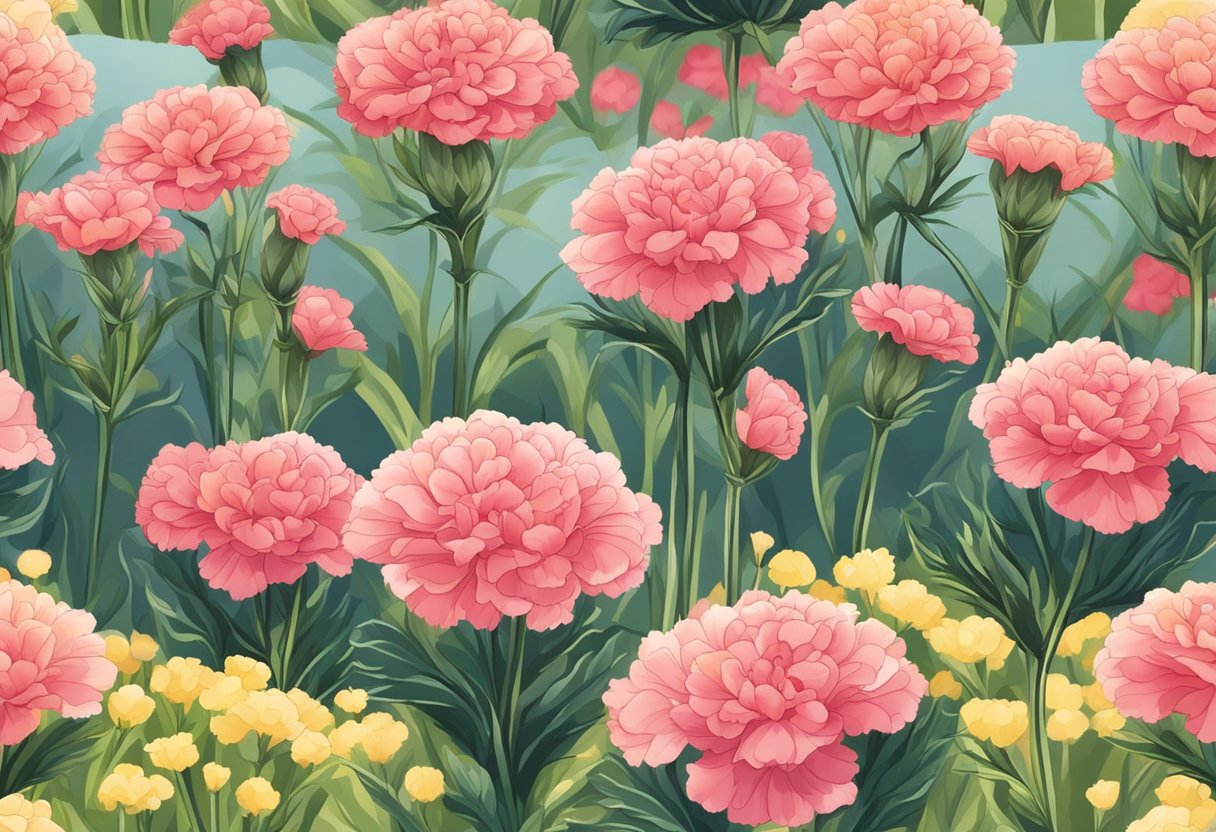When it comes to planting carnations, timing is essential to ensure healthy growth and vibrant blooms. Carnations thrive when planted at the start of the cool weather in spring or fall, depending on your climate zone. In my experience, planting them after the last frost in spring gives them enough time to establish roots before the high heat of summer. Conversely, autumn plantings should be done well before the first frost to allow the plants to settle in before winter.

For most regions, the optimal time to plant carnations is either in the spring after the last frost or in the fall, when temperatures start to drop but the ground hasn’t frozen yet.
Carnation care in the garden involves selecting a sunny spot with fertile, well-draining soil. I’ve learned that using compost improves soil fertility, promoting better growth. Moreover, ensuring sufficient space between plants for air circulation helps to prevent disease. Carnations prefer a sunny location because ample sunlight leads to stronger stems and more prolific flowering. Regular watering and pruning also play critical roles in extending the blooming period and keeping the plants healthy.
JUMP TO TOPIC
The Cultivation of Carnations
Carnations (Dianthus caryophyllus), also known as garden pinks, are famed for their vibrant colors, ruffled petals, and spicy fragrance. Successful cultivation requires careful attention to planting, soil conditions, and ongoing care. I will guide you through each step to ensure that your carnations grow healthy and strong.
Planting and Propagation
- Seeds: Sow carnation seeds in spring directly into the garden or start them indoors in pots with well-draining soil.
- Cuttings: Take cuttings from healthy plants in late summer for overwintering in a cool, frost-free area.
- Division: In the early spring, divide established clumps to propagate new plants.
Plant seeds about 1/8 inch deep in well-draining soil and keep them moist. For cuttings and division, select healthy parent plants to increase the likelihood of vigorous offspring. Once started indoors, harden off seedlings by gradually exposing them to outdoor conditions before planting out.
Soil and Sunlight Requirements
Carnations thrive in fertile, humus-rich soil with a neutral pH. Use a mix of potting soil and compost to enrich the soil bed before planting.
Proper drainage is crucial to avoid root rot, so ensure that the planting area does not retain standing water.
Watering and Fertilization
Consistent watering is key, especially during dry spells. However, avoid overwatering as this can also lead to root rot.
| Fertilization Schedule | Early Spring | Growing Season | Bloom Period |
|---|---|---|---|
| What to Use | Balanced fertilizer | High nitrogen formula | Phosphorus-rich to promote blooms |
Apply fertilizer in early spring to support growth and change the formulation as the plant moves through its life stages. During the flowering period, a phosphorus-rich fertilizer will encourage more vibrant blooms. Regularly monitor soil moisture and adjust watering as necessary to maintain a consistent level of moisture without waterlogging.
Caring for Carnations Throughout the Season
Seasonal care for carnations ensures their vibrant blooms and robust health from spring through fall. Proper maintenance and vigilant pest and disease control are paramount.
Seasonal Maintenance
I begin my carnations’ care in early spring, watching for the last frost to pass before planting. Once my carnations are in the ground, I follow this routine:
Addressing Pests and Diseases
I keep an eye out for the common enemies of my carnations: mites, rust, and aphids. Early detection is key, so inspecting my plants regularly allows me to act promptly. Here’s what I look out for and how I address these issues:
| Pests/Disease | Identification | Treatment |
|---|---|---|
| Mites | Small, spider-like insects; webbing on plants | I use a strong spray of water or introduce beneficial insects like ladybugs. For severe cases, I might apply miticides. |
| Rust | Orange or brown pustules under leaves | Increased air circulation is important. Infected leaves must be removed, and fungicides may be applied if necessary. |
| Aphids | Tiny green or black insects clustered on new shoots | I control them by spraying with water, using insecticidal soap, or neem oil as a natural deterrent. |
💥 Remember: Consistent monitoring is the best way to maintain the health of carnations and address any problems that arise swiftly.
The Aesthetics and Varieties of Carnations
The carnation, with its rich palette of hues and distinctive fragrant blossoms, is a florist’s favorite for creating vivid and perfumed arrangements. When selecting varieties for a garden or bouquet, one must consider both visual appeal and olfactory charm.
Color and Cultivar Selection
Carnations come in a spectrum of colors: classic red, pure white, soft pink, sunny yellow, multi-hued patterns, and even rare purple and coral shades. Each color can profoundly influence the visual dynamic of a garden space or floral arrangement. They are broadly grouped into standard carnations, with a single large flower on a stem, and spray carnations, which have smaller blooms clustered at the terminal ends of each stem.
Fragrance and Cutting for Arrangements
The spicy fragrance of carnations is as much a part of their appeal as their beauty. As a cut flower, carnations are prized for their longevity and their ability to rebloom even after cutting. They offer an inviting aroma that can transform any space. Cutting flowers for arrangements also encourages plants to produce new blooms, keeping your garden or home filled with vibrant petals and fresh scents year-round.
💥 Regular cutting of spent flowers ensures reblooming and prolongs the garden’s visual and aromatic display.












